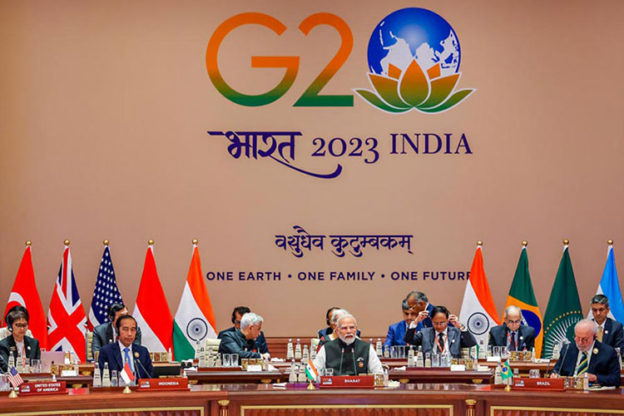India and the U.S. are expected to deepen their partnership across several areas, including energy, following a G20 summit. In an attempt to counter Chinese dominance, the countries’ leaders are focused on strengthening their relationship to support India’s economy, boost trade, and accelerate the global green transition. This follows several previous discussions between the two powers focused on enhancing their collaboration on energy, particularly clean energy and related technologies.
At the G20 summit held in Delhi, India this month, Indian Prime Minister Narendra Modi and U.S. President Joe Biden pledged to deepen their ties. This marks their second bilateral meeting in under six months. In a personal meeting between the two leaders at Modi’s official residence, they delivered a 29-point statement, which highlighted the main areas of focus in their new relationship. It included constructing resilient strategic technology value chains and collaboration on renewable and nuclear energy, as well as climate financing.
A joint statement from the meeting outlined several areas of cooperation between India and the U.S., many of which were closely linked to the energy sector. The two powers will support the building of resilient global semiconductor supply chains, including a multi-year initiative of Microchip Technology, Inc., to invest approximately $300 million in expanding its research and development presence in India and Advanced Micro Device’s announcement to invest US$400 million in India. They also reiterated the importance of nuclear power in providing greater energy security in the green transition. India and the U.S. expect to collaborate on the development of both countries’ nuclear power capacity, as well as on the construction of next-generation small modular reactor technologies.
No representatives from China or Russia attended the recent G20 meeting, which India and the U.S. hope will demonstrate to the Global South that the remaining G20 countries provide a more realistic proposition for food security to debt resolution. The summit was aimed at accelerating sustainable development, enhancing multilateral cooperation, and developing a global consensus for inclusive economic policies. During talks, Biden and Modi emphasised the importance of The Quad, an informal security alignment between Australia, India, Japan and the U.S. to counter China’s power in the Indo-Pacific region.
When it comes to energy, the U.S. and India have been working more closely together in recent years. In June, USAID and Indian Railways announced a Memorandum of Understanding to combat climate changeand achieve Indian Railways’ target of net-zero carbon emissions by 2030. Together, the two partners aim to accelerate the development of renewable energy capacity, enhance energy efficiency and energy storage technologies, and align with the net-zero goal.
In July, the U.S. Secretary of Energy Jennifer M. Granholm and Indian Minister of Petroleum and Natural Gas Hardeep Singh Puri hosted the third ministerial meeting of the U.S.-India Strategic Clean Energy Partnership(SCEP), which began in 2021. The partnership builds upon work by government, industry, and other stakeholders to enhance energy security, build the countries’ clean energy capacity, and decarbonise. The two representatives emphasised the importance of bilateral energy cooperation for enhancing energy security, boosting employment, and supporting the global green transition.
The SCEP is expected to grow energy trade between the two powers, as well as encourage greater innovation in clean energy technology, such as battery storage and green hydrogen. Both countries view green hydrogen as key to the global energy transition and will support one another in the development of their green hydrogen capacity and the development of new hydrogen technologies to reduce production costs. SCEP also focuses on deepening the cooperation between the public and private sectors to support decarbonisation.
Despite deepening ties with the U.S., India plans to continue its energy trade with Russia, even in the face of mounting criticism from several major world powers. India’s imports of Russian crude increased ten-fold in 2022, according to Indian state-controlled lender Bank of Baroda. This was due to the huge price reduction of Russian oil following sanctions imposed on Russian energy from the U.S. and Europe. To ensure it could continue to export oil and maintain its revenues, Russia has sold crude at a highly discounted price, attracting trade with major powers such as India and China.
But India’s main energy company, the Oil and Natural Gas Corporation (ONGC), believes that India’s import of Russian crude is a win-win for the world economy. K.C. Ramesh, the executive director of ONGC, recently explained, “By importing from Russia, India also has helped the global economy in the sense that [we] freed up some oil on the Gulf for other countries to source, particularly Europe. So, it was kind of a win-win situation.” He added, ″[It has] a very huge impact on our economy, in terms of helping the [Indian] economy grow … the price being very reasonable that we get from Russia.”
The U.S. is continuing to deepen its energy partnership with India to help develop its role in the Asian region, as well as to enhance energy security and support the global green transition. The recent G20 summit emphasised the two powers’ commitment to deepening ties across several areas, including energy. This comes despite India’s continued purchase of Russian crude and failure to condemn the Russian invasion of Ukraine.
By Felicity Bradstock for Oilprice.com
https://oilprice.com/Energy/Energy-General/India-And-US-Strengthen-Energy-Ties.amp.html





